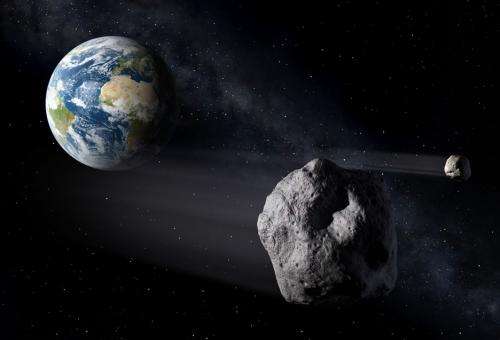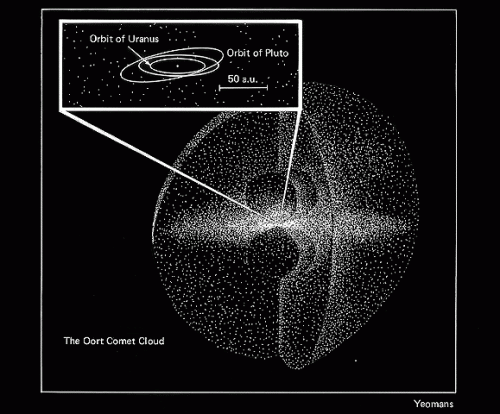What is the difference between asteroids and comets?

Asteroids and comets have a few things in common. They are both celestial bodies orbiting our Sun, and they both can have unusual orbits, sometimes straying close to Earth or the other planets. They are both "leftovers"—made from materials from the formation of our Solar System 4.5 billion years ago. But there are a few notable differences between these two objects, as well. The biggest difference between comets and asteroids, however, is what they are made of.
While asteroids consist of metals and rocky material, comets are made up of ice, dust, rocky materials and organic compounds. When comets get closer to the Sun, they lose material with each orbit because some of their ice melts and vaporizes. Asteroids typically remain solid, even when near the Sun.
Right now, the majority of asteroids reside in the asteroid belt, a region between the orbits of Mars and Jupiter which may hold millions of space rocks of varying sizes. On the other hand, the majority of comets are in the farthest reaches of our Solar System: either 1. in the Kuiper Belt—a region just outside the orbit of the dwarf planet Pluto that may have millions of icy comets (as well as many icy dwarf planets like Pluto and Eris); or 2. the Oort Cloud, a region where trillions of comets may circle the Sun at huge distances of up to 20 trillion kilometers (13 trillion miles).
Some scientists think asteroids formed much closer to the Sun, where it was too warm for any ices to remain solid, while comets formed farther from the Sun and were therefore able to retain ice. However, other scientists think that the comets that are now in the Kuiper Belt and Oort cloud actually formed in the inner Solar System, but were then flung out from the gravitation effects of the giant planets Jupiter and Saturn.
We do know that gravitational perturbations periodically jar both asteroids and comets from their usual "homes"—setting them on orbital courses that bring them closer to the Sun, as well as Earth.
When comets approach the Sun, some of their ices melt. This causes another notable difference between asteroids and comets: comets have "tails" while asteroids generally don't. When the ices in comets begin to melt and other materials vaporize from the heat from the Sun, this forms a glowing halo that extends outward from the comet as it sails through space. The ice and compounds like methane and ammonia develop a fuzzy, cloud-like shell called a coma. Forces exerted on the coma by the Sun's radiation pressure and solar wind cause an enormous, elongated tail to form. Tails always points away from the Sun.

Asteroids typically don't have tails, even those near the Sun. But recently, astronomers have seen some asteroids that have sprouted tails, such as asteroid P/2010 A2. This seems to happen when the asteroid has been hit or pummeled by other asteroids and dust or gas is ejected from their surfaces, creating a sporadic tail effect. These so-called "active asteroids" are a newly recognized phenomenon, and as of this writing, only 13 known active asteroids have been found in the main asteroid belt, and so they are very rare.
Another difference between asteroids and comets is in their orbital patterns. Asteroids tend to have shorter, more circular orbits. Comets tend to have very extended and elongated orbits, which often exceed 50,000 AU from the Sun. (*Note: 1 AU, or Astronomical Unit, equals the distance from the Earth to the Sun.) Some, called long-period comets come from the Oort Cloud and are in big elliptical orbits of the Sun that take them far out beyond the planets and back. Others, called short-period comets come from the Kuiper Belt and travel in shorter orbits around the Sun.
There is a big difference when it comes to numbers… although there is a caveat in that we don't know precisely how many asteroids OR comets there are in our Solar System, since many have never been seen. Astronomers have discovered millions of asteroids – some as small as dust particles and others measuring hundreds of kilometers across. But as of this writing, astronomers have found only about 4,000 comets. However, some estimates say there could be one hundred billion comets in the Oort cloud.
The fact that asteroids and comets were both formed during the earliest days of our Solar System has scientists studying both with keen interest. By examining them up close with satellites and landers—such as the current Rosetta mission with the Philae lander to Comet 67P—scientists hope to learn more about what our Solar System looked like in its earliest days. Here's a list of missions to asteroids and comets.
We also know that both comets and asteroids are in other solar systems beyond our own. In 2012, scientists using the Spitzer Space Telescope witnessed what they think was a crash between two huge asteroids orbiting another star 1,200 light-years. In 2011, astronomers saw evidence of comets pummeling a planet orbiting the star Eta Corvi, which is about 59 light-years away from us.
Scientists also study comets and asteroids to determine the likelihood of them hitting Earth and other planets, and what effect their flybys could have on planetary atmospheres. In November of 2014, a comet named Siding Spring flew very close to Mars, and scientists are still studying the encounter. But this may happen more often that we think: one recent study says that Mars gets bombarded by 200 small asteroids or comets every year.
How likely is it that our planet could be hit by a large asteroid or comet? We do know that Earth has been hit many times in the past by asteroids and comets whose orbits bring them into the inner Solar System. There is strong scientific evidence that cosmic collisions played a major role in the mass extinctions documented in Earth's fossil records. These objects that come close to Earth, known as Near Earth Objects or NEOs, still pose a danger to Earth today. But NASA, ESA and other space agencies have search programs that have discovered hundreds of thousands of main-belt asteroids, comets. None at this time pose any threat to Earth.
Additionally, the possibility of mining both asteroids and comets someday is also becoming a source of interest for industrialists and commercial space ventures, such as Planetary Resources.
Want more resources on asteroids? Here's an infographic on the differences between asteroids, comets, meteors and meteoroids. Here's NASA's Lunar and Planetary Science page on asteroids. And here's Hubblesite's news releases about asteroids.
More information: You can find out more on this topic at NASA's Near Earth Object Program website: neo.jpl.nasa.gov/neo/
Source: Universe Today





















